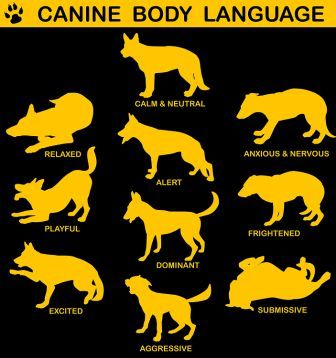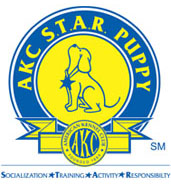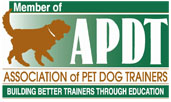Over the years of training my own dogs, teaching classes, and talking to dog owners on the phone. I hear the same stories over and over again. I ask the same questions. I offer advise. Each dog and situation may be slightly different, so this is generic advice I offer here. Please keep this in mind (this is my disclaimer). Also, advise may vary from trainer to trainer. If you tell me you are going to another trainer, I will not tell you they are wrong, but may offer other alternate methods. These are my thoughts/suggestions/tips I'm sharing. If you use these, please give me credit. I'd love to hear some feed back from you. Sincerely, Kath Cook
Humans as Pack Leaders
Pack animals, BOTH females and especially males, seem to be ready to challenge to be the pack leader if they sense weaken in the current pack leader. This keeps the pack "healthy". However, humans tend to make poor pack leaders. An "unhealthy" and unsafe situation generally ensues. Many of these dogs end up ruling the family, put in the back yard in a kennel or on a chain, end up at the pound, in rescue (if they haven't bitten anyone, yet), or euthanized. The lucky ones are rehabilitated with time and training.
My first observation is that Mike and I have had German Shepherds, male and female, for over 35 years. We have NEVER had one question our authority or try to become the pack leader over us. Are we lucky? I don't think so. We never allow them to think we are weak pack leaders, so they have no reason to feel obligated to become the pack leader. We are confident enough with our leadership, that we can do many things that you should never do (we allow our dogs to sleep on the bed, play tug, play rough). I don't recommend these activities with dogs with dominance issues.
We may be the pack leader overall, but this does not ensure that ALL dogs (especially high drive dogs) get along with each other. In our case, we have 6 dogs (which includes 4 intact males) we want the high drive for competing. You do not want the dogs we love to have! We train first, and then manage the situation as necessary. In extreme cases, the use of crates and gates can be essential in keeping dogs from harming each other, and peace in the household. Dog-on-dog aggression is something we have lived with and successfully managed. Each dog still gets quality time and training, just not in the same place at the same time. We know who gets along with who and who does not. From my training classes and phone calls, I have seen a rise in such behavior since more people are gravitating towards breeding to beautiful (and high drive) dogs. Your puppy may not be out of this immediate breeding, but you may have gotten him from a "next generation" litter in which the physical attributes, healh issues, temperament, and drive is still genetically linked to past generations. Not just German Shepherds, but other breeds. I am seeing a lot of this in Border Collies, Golden Retrievers, and Labrador Retrievers.
The calls I receive are generally owners of MALE GERMAN SHEPHERDS, 9 MONTHS old or 18 -24 MONTHS old. These dogs are taking over. They are either teenagers, testing the waters, or adult males coming into their full maturity. It's their obligation to challenge.
My advise should have been asked when the dogs were 8 weeks old. TRAIN TRAIN TRAIN. Establish his place in the pack. Take your puppy to training classes.
Since you haven't started at 8 weeks, it's going to take a LOT more work. Take some assertiveness training. TRAIN TRAIN TRAIN. Establish his place in the pack. Take your dog to training classes. But make sure the training classes you attend actually teach control methods!
You may like this article titled "Every Dog Needs A Number".
Rules to Training your Dog: This is the same for Pet Training as well as Competition Training
- Praise/reward correct behavior.
Behavior which is rewarded tends to occur again. - Do not praise/reward incorrect behavior.
If you reward a "crooked front", you will get a "crooked front". - Be consistent.
Dogs don’t understand “Sometimes”. - ALWAYS Be prepared to follow through.
Always be ready to correct or reward. If he jumps on you, be ready to correct it no matter what you are wearing! Otherwise, he's going to think he can do it. - Set realistic goals.
Decide what you can live with. Don't spend time and energy on something you really don't care that he does that behavior. - You need your dog’s attention in order for him to learn.
Just like kids, if he's busy sniffing/playing with a toy, he's not going to listen to you. - Make sure your dog knows his place in the “Pack”.
See above lesson, HUMAN AS PACK LEADER. - Make sure you and your dog are working on the same thing.
You may be working on Sit/Stay, he thinks he's working on jump up on dad. - Teach one thing at a time.
If you are working on Come Front, try not doing a Sit/Stay. If he breaks the Sit/Stay, you have to address it. - Timing is everything.
Always start and end a training session on a positive note. Do something he does well so he can get praised and treats. Corrections and praise should be quick. I do it within 2 seconds of the behavior. - Your command, voice, and body language must all say the same thing.
Dogs are very visual and attune to verbal nuances. I don't use a clicker, but practice keeping my praise to 1 consistent, non-emotional word. I try to keep commands to a 1 syllable word. - Dogs don't take hints.
Tell him what you want. Reward if he does something right. Correct/ignore if he doesn't do it right. - You can correct a behavior at the beginning of a behavior chain.
Don't wait until he actually does something wrong if you can see he's "thinking" about do it. - I use any distraction that presents itself as a training opportunity!
- Use the right tool for training your puppy/dog. And use the tool right!
- There is NO cheating in dog training (only in dog showing).
If it seems too easy, and you are getting the desired results, you are doing it right!
House Breaking your Puppy
I've come up with a flow chart to assist your effort in housebreaking your puppy.
Pick an extended weekend and concentrate on your puppy's toilet habits. Your days will be boring and will consist of "Take the puppy out, bring the puppy in." "Take the puppy out, bring the puppy in." "Take the puppy out, bring the puppy in." You get the message. There are additional help tips on the bottom of the flow chart. Click here for flowchart .
- Use the same door. This will teach the puppy that door means potty, and teach you to watch for your puppy going to that door.
- Watch him. If he goes to the door, take him out. Even if he doesn't go, it's teaching him that going to the door will get him out. This means the door needs to be in view.
- Take them to the same spot they have used before. The scent it there, and will encourage them to go.
- PRAISE and use this as a training opportunity. "Good Potty."
- Later, you can say "Go Potty." My dogs will "go" on command (if they need to go).
- If you don't catch your puppy in the act of squatting, you've missed your chance to teach him.
- Take your puppy out! You need to praise him. Just letting him out, doesn't give you a good enough view and chance to praise.
- Watch his tail. Tail curving up means he's urinating. Tail curving down means he's defecating.
- Males generally don't begin lifting their leg until they are between 1-2 years old. (Yes, I've had females also do leg lifting).
Canine Body Language
What is your dog "telling" you? Use this chart to help you identify what your dog is feeling.


.png)


